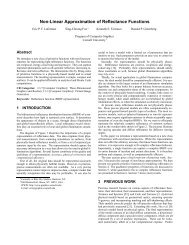pigmented colorants: dependence on media and time - Cornell ...
pigmented colorants: dependence on media and time - Cornell ...
pigmented colorants: dependence on media and time - Cornell ...
You also want an ePaper? Increase the reach of your titles
YUMPU automatically turns print PDFs into web optimized ePapers that Google loves.
The vascular tunic lies <strong>on</strong> the wall of the eyeball for the rear two thirds, c<strong>on</strong>sist-<br />
ing of a heavily <str<strong>on</strong>g>pigmented</str<strong>on</strong>g>, sp<strong>on</strong>gy structure called the choroid. It c<strong>on</strong>tains a vast<br />
network of blood vessels <strong>and</strong> capillaries that provide oxygen <strong>and</strong> nourish a very<br />
important class of cells in the retina, the photoreceptors, that turn light into neu-<br />
ral signals. The choroid’s dark pigmentati<strong>on</strong> also helps absorb light not captured<br />
by the photoreceptors, save stray light from diminishing the quality of the image<br />
that reaches the eye. Incidentally, this is the same reas<strong>on</strong> the inside of a camera<br />
is painted flat black–the paint absorbs scattered light <strong>and</strong> protects the sharpness<br />
of images <strong>on</strong> the film. Toward the fr<strong>on</strong>t of the eye, this middle, choroidal layer<br />
breaks away from the outer layer <strong>and</strong> runs roughly parallel to the fr<strong>on</strong>t of the eye.<br />
This secti<strong>on</strong> of the middle layer forms a slender sp<strong>on</strong>gy structure called the ciliary<br />
body which produces aqueous humor, the watery fluid that fills the cavities in the<br />
eye. This fluid performs important maintenance to the eye, including supplying<br />
oxygen <strong>and</strong> nutrients to the cornea <strong>and</strong> lens <strong>and</strong> carrying waste away. The fluid<br />
also maintains the c<strong>on</strong>stant pressure in the eye. If there is too little fluid, the eye<br />
becomes deformed <strong>and</strong> light does not focus correctly <strong>on</strong> the back of the eye. If<br />
there is too much pressure for too l<strong>on</strong>g, visi<strong>on</strong> can be impaired permanently–the<br />
c<strong>on</strong>diti<strong>on</strong> called glaucoma.<br />
As it curls inward, the ciliary body gives way to the iris, that circular tissue<br />
that gives your eye its characteristic color. The iris actually c<strong>on</strong>tains two layers, an<br />
outer layer c<strong>on</strong>taining pigment <strong>and</strong> an inner layer c<strong>on</strong>taining blood vessels. If the<br />
outer layer is heavily <str<strong>on</strong>g>pigmented</str<strong>on</strong>g>, the iris appears brown. If it is lightly <str<strong>on</strong>g>pigmented</str<strong>on</strong>g>,<br />
the inner layer is partially visible through the outer <strong>on</strong>e <strong>and</strong> the iris takes <strong>on</strong> a<br />
lighter color. The pupil, or black regi<strong>on</strong> in the eye is not an object, but actually<br />
a gap within two sets of muscles in the iris. The inner set runs in a circle around<br />
58



